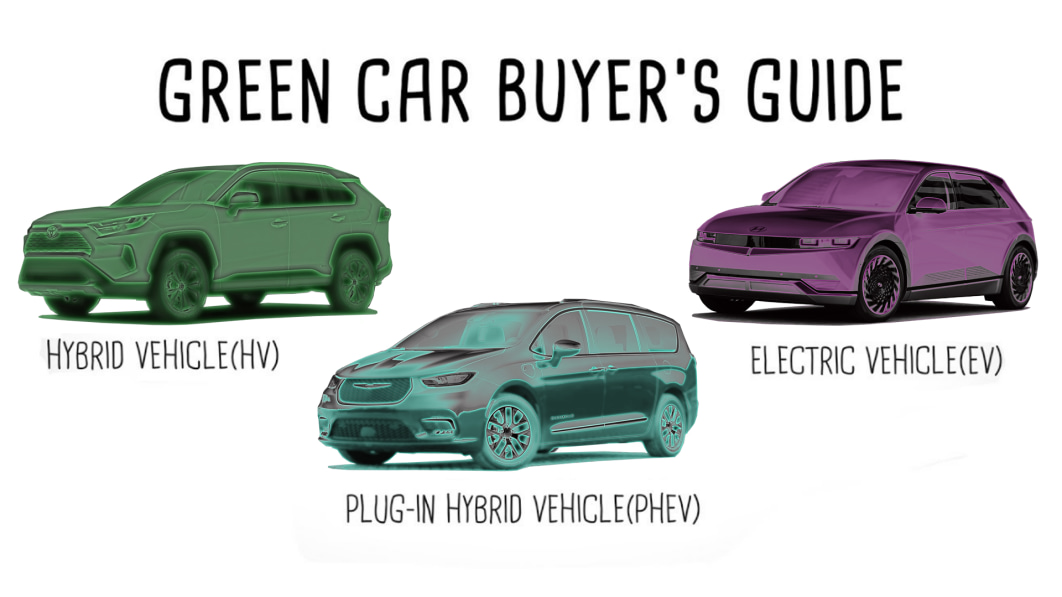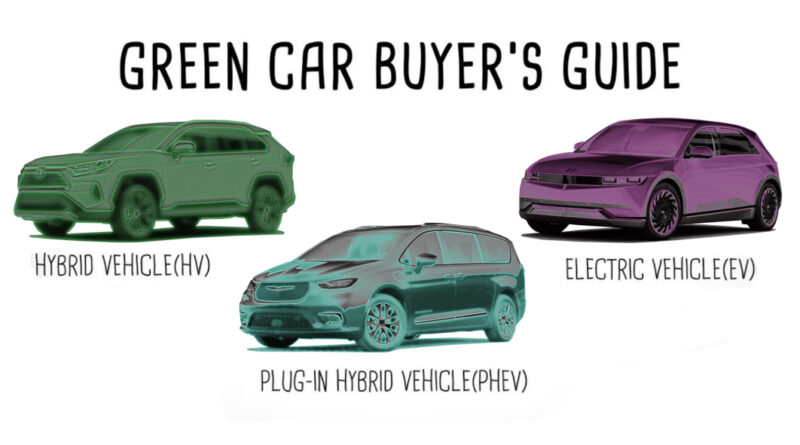EVs vs Hybrids vs Plug-in Hybrids: What’s the difference?

If you’re looking for a greener, more efficient mode of transportation, there are loads of options with a variety of different drivetrains. There are partly electrified cars such as hybrids and plug-in hybrids, and then there are fully electric cars. That selection is great, but it can also be a little overwhelming in figuring out which electric vehicle is best for you. So we’re going to break down what each vehicle is, and what situations each are most suited to. We’ll even cover those differences both in text below, and the video at top. And even though the video above is a little dated in terms of available models, electric ranges and other specs, but still does a great job of explaining the mechanical differences and what that means to how they drive and how much fuel they’ll save.
Hybrid Vehicles (HV or HEV)
A hybrid vehicle, sometimes referred to as an HEV for hybrid electric vehicle, has two powertrains, one gasoline and one electric, which work together for maximum efficiency. In some situations, the engine can shut off entirely, relying solely on the electric motor. The battery is charged by capturing energy from the braking system or directly from the gas motor. Hybrids come in all shapes and sizes, and the most fuel efficient today can return almost 60 miles per gallon. Hybrids are excellent choices if you’re regularly driving long distances, can only have one car, and/or you don’t have a place you can plug a vehicle in. All you have to do is keep it filled with gas, and you don’t have to worry about finding chargers.
Plug-In Hybrid Vehicles (PHEV)
A plug-in hybrid, also called a PHEV (plug-in hybrid electric vehicle), is a step towards full electrification. PHEVs typically can go between 10 and 50 miles on electricity alone. Once the battery is drained, PHEVs operate like conventional hybrids and switch between gas and electric operation seamlessly.
Now, PHEVs do require some extra effort. To get the maximum EV range every time you drive, you’ll need to plug into a charger daily, but the beauty of the PHEV is its flexibility. For example, a Toyota RAV4 Prime with fully-charged battery can travel 42 miles on electricity alone. That’s enough for most commutes. Add a full tank of gas, and the combined range extends to a massive 600 miles. The PHEV’s best for people with short commutes who can take full advantage of the EV-only capabilities, but who also routinely venture out on longer-distance trip where recharging an EV would be inconvenient or impossible. Access to a charger in your home or workplace is essential to get the most out of a PHEV. If you can’t plug in your plug-in hybrid regularly, you’ll likely get worse fuel economy than if you got just a regular hybrid, mainly because you’ll be hauling a bunch of extra weight in the form of a battery you’re not using.
Electric Vehicles (EV)
Electric vehicles, or EVs are true to their name. Fully electric with no gasoline engine even as a backup. Today’s EVs have EPA-estimated ranges that can top 500 miles, but most are in between 200 and 350 miles. Highway driving, cold weather and driving habits can all negatively impact an EV’s range in a dramatic fashion, and since recharging is a more time-consuming process with far fewer stations, you need to plan your trips carefully.
Also, the EV driving experience is different from a traditional car. EVs offer a strong swell of power from a stop, something most drivers like. Let off, and most EVs will begin harvesting energy to regenerate the battery charge. This regenerative braking effect can be so strong, it’s possible to “one-pedal drive” most of the time. It’s a little strange at first, but can be fun after a while and a real help when stuck in stop-and-go traffic. Many EVs that have a one-pedal setting, can have that turned off or reduced for a smoother or more traditional driving feel.
EVs are best for urban drivers who have a short commute, access to a charger, and are comfortable planning a charging strategy ahead of time so they don’t run out of juice on the road. Thankfully, doing so is getting increasingly easy (especially if you go with Tesla and its exclusive network of Supercharger stations) and more chargers are opening up all the time from multiple companies such as Electrify America. You’ll need to know the differences in charging speed and how much electricity your car can swallow, but that’s easy enough information to find and understand.
EVs are also a good choice if you don’t have to have just one car in your garage. That way, you can have an EV for short to medium-range drives, and a gas-powered car for long-distance drives. But as charging infrastructure improves, EVs will become better suited for longer-distance travel, too.
With a little preparation, you can find the green vehicle that best fits your lifestyle, and remember, Autoblog’s Car Finder is always there to help. Happy hunting.




